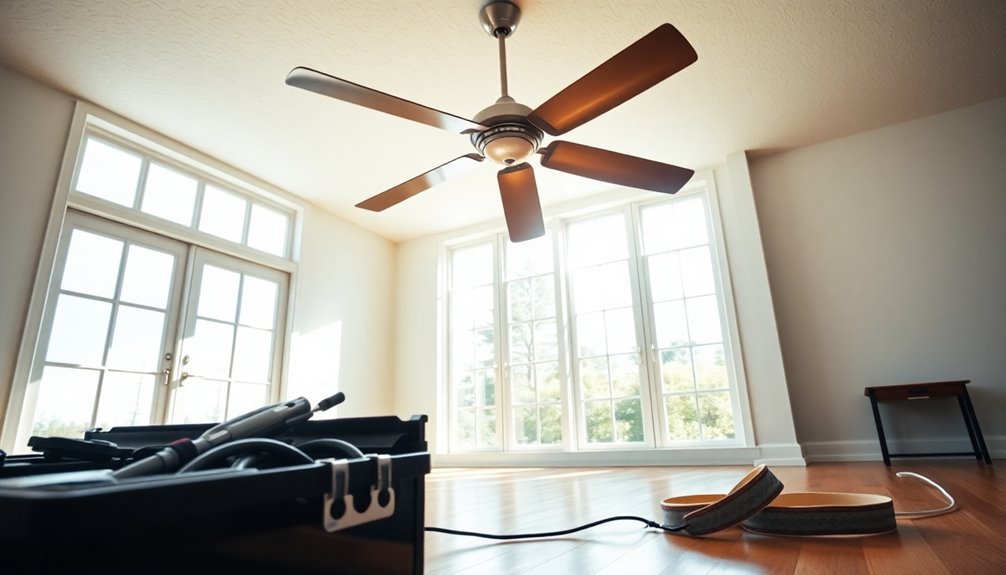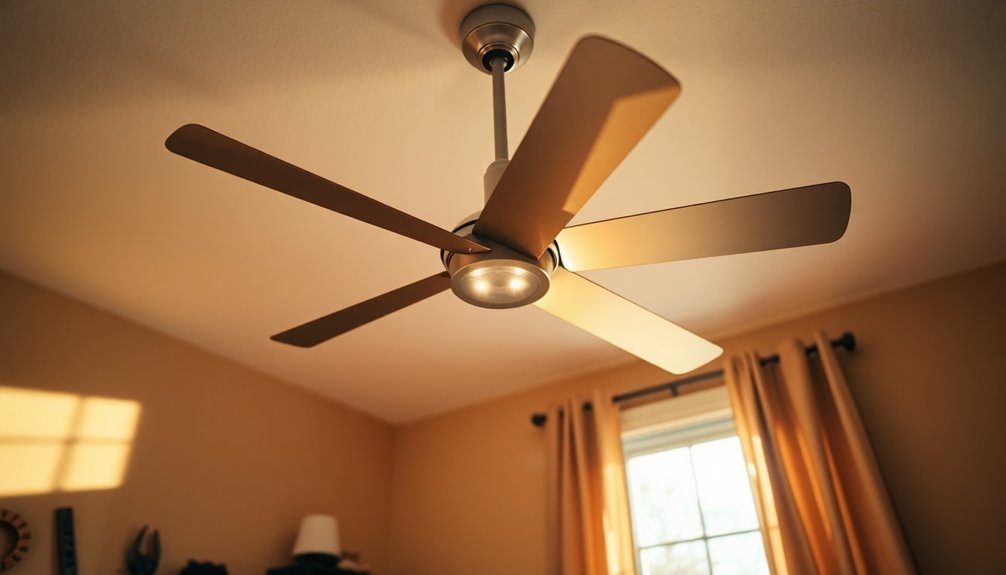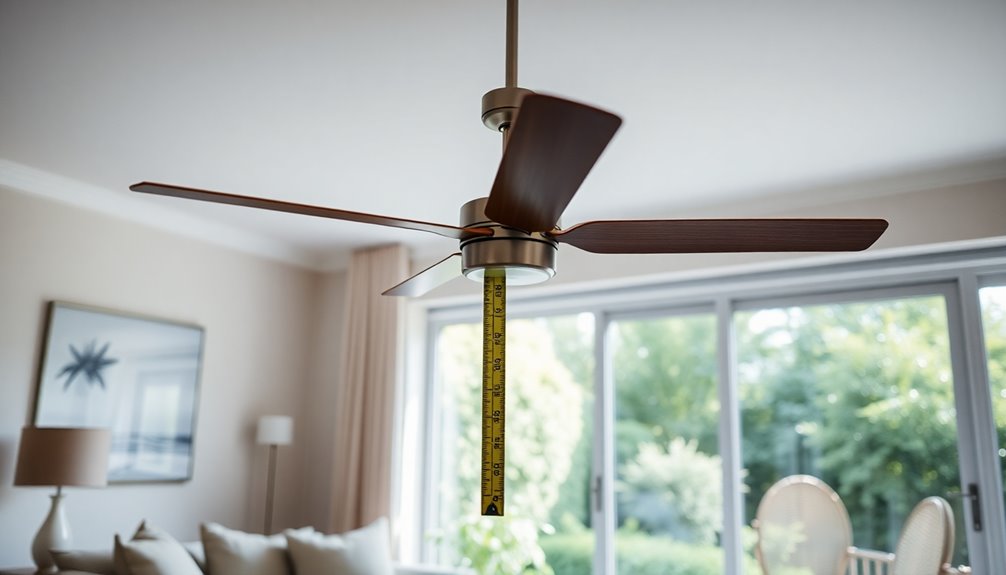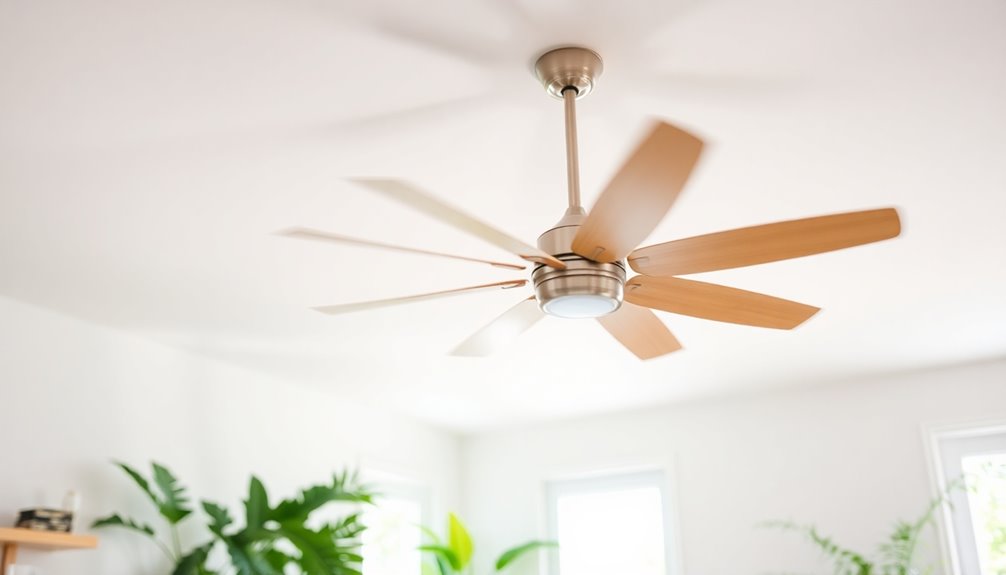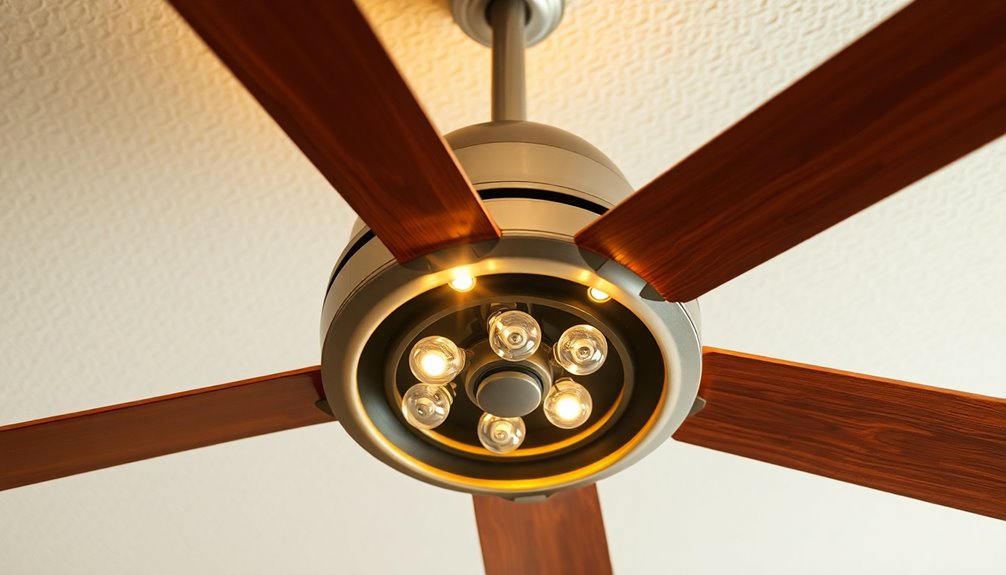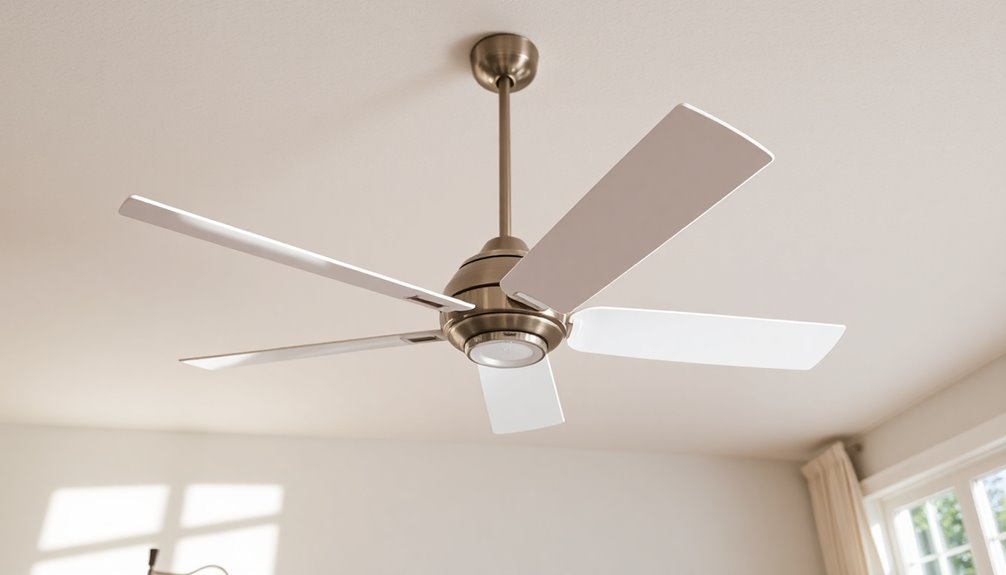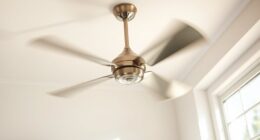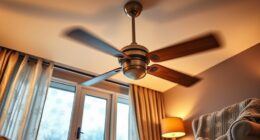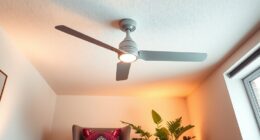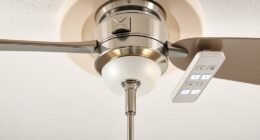Installing a ceiling fan with existing wiring usually costs between $144 and $354, with the average around $249. The total cost depends on the fan type and features you choose. Factors like local labor rates and installation complexity also affect the price. Basic installations generally take about 1 to 2 hours, while more complex setups can take longer. If you're contemplating adding features like integrated lighting or remote controls, expect to spend an extra $30 to $100. There's a lot more to ponder, so keep going to uncover some helpful tips and insights on this topic.
Key Takeaways
- Installation costs for ceiling fans with existing wiring typically range from $144 to $354, averaging around $249.
- Labor costs for installing ceiling fans can range from $100 to $500, depending on local rates and complexity.
- Basic installations usually take 1 to 2 hours, while complex setups may require 2 to 4 hours.
- Additional features, like integrated lighting or remote controls, can increase total installation costs by $30 to $100.
- Purchasing fans during off-peak seasons or scheduling multiple installations can help reduce overall expenses.
Cost Overview of Ceiling Fan Installation

When considering a ceiling fan installation, you can expect to spend anywhere from $100 to $500, depending on the fan type and any extra features you choose.
The average installation cost for a ceiling fan with existing wiring typically falls around $249, though it can vary within a price range of $144 to $354. Labor costs play a significant role in these expenses, usually averaging between $50 to $250 per hour.
For basic installations that utilize existing wiring, you might spend about 1 to 2 hours for completion. However, if you're dealing with complex setups, you could see the installation extend to 2 to 4 hours.
Additional features—like remote controls or integrated lighting—can also influence your total average installation cost, potentially adding $30 to $100 to your expenses.
Factors Influencing Total Costs

When you're planning to install a ceiling fan, several factors can impact your total costs.
The type of fan you choose, local labor rates, and any additional features can all play a significant role in how much you end up spending.
Understanding these elements will help you make informed decisions and budget effectively.
Type of Ceiling Fan
Choosing the right type of ceiling fan can greatly impact your installation costs. If you opt for a standard ceiling fan, you might spend between $50 and $300, while low-profile and smart fans can range from $100 to $400.
These price differences can greatly influence your overall ceiling fan installation cost, especially when using existing wiring. Features like integrated lighting and remote controls can add an extra $30 to $100 to your expenses.
Additionally, if your ceiling height requires extended downrods, expect to pay between $10 and $75, which also affects your budget.
When considering the types of ceiling fans, energy-efficient models or those with advanced technology can raise the cost considerably, sometimes reaching up to $1,850 for high-end options.
Remember, the more features and technology you include, the higher the installation cost will be. As a result, it's essential to assess your needs and preferences carefully to avoid unexpected expenses.
Ultimately, selecting the right ceiling fan not only enhances your space but can also help manage your overall costs effectively.
Labor Rates Variability
The cost of installing a ceiling fan isn't just about the fan itself; labor rates play a significant role in determining your total expenses. These rates can vary widely based on several factors, including location, project complexity, and the type of professional you hire. Generally, electricians charge between $60 to $100 per hour, while handypersons may offer lower rates of around $60 to $65.
Factors like ceiling height and accessibility can increase installation complexity, leading to higher labor costs. Local market conditions also influence labor rates, affecting your overall project costs.
Here's a quick overview of how these factors can impact your expenses:
| Professional Type | Hourly Rate | Installation Time (1-2 hours) |
|---|---|---|
| Electricians | $60 – $100 | $100 – $200 |
| Handypersons | $60 – $65 | $60 – $130 |
| Complex Installations | $100 – $250 | $200 – $500 |
When using existing wiring, you're looking at labor costs that can range from $100 to $500, depending on the installation time and labor rates in your area.
Additional Features Impact
Installing a ceiling fan can quickly become more expensive due to various additional features that enhance functionality and aesthetic appeal.
When considering your ceiling fan installation cost, remember that features like integrated lighting kits or remote control options can add $30 to $100 to your overall expenses.
If your ceiling is high, a longer downrod might be necessary, increasing costs by $10 to $75 depending on the required length.
Smart technology, such as SIMPLEconnect® WiFi integration, can greatly raise your installation costs, with prices ranging from $179.99 to $549.99.
The complexity of your installation, including the features you choose, will directly impact how much you'll pay.
Additionally, if you're planning to install multiple fans simultaneously, you could save on labor costs, making it a more economical option.
Types of Ceiling Fans and Prices

When considering the various types of ceiling fans available, you'll find a wide range of prices that cater to different needs and preferences.
Standard models are the most common and typically range from $50 to $300, depending on design and features. If you have low ceilings, low-profile fans are a great option, usually priced between $100 and $200.
For those looking to embrace modern technology, Smart Home ceiling fans offer app-controlled functionality and can cost anywhere from $120 to $400.
If you're concerned about air circulation, dual-motor fans might be what you need. These fans can be quite an investment, ranging from $120 to $1,500, depending on size and complexity.
Finally, Energy Star-rated ceiling fans are known for their efficiency and generally cost between $200 and $300, offering you significant energy savings compared to standard models.
When you decide to install a ceiling fan with existing wiring, keep these ceiling fan costs in mind to find the best fit for your home and budget.
DIY Installation vs. Professional Help

While you might be tempted to tackle the installation of a ceiling fan yourself, weighing the pros and cons of DIY versus hiring a professional is essential.
With DIY installation, you could save between $50 to $200 on labor costs, with total expenses typically ranging from $100 to $275 for materials and learning resources. If your existing wiring is adequate, the average installation time is around 1 to 2 hours, but inexperienced individuals might need more time.
On the flip side, hiring professional electricians guarantees safety and compliance with electrical codes. They charge between $60 to $250 per hour, with installation costs averaging around $200 to $700, depending on local labor rates. If you encounter issues or need upgrades to your existing wiring, it's wise to have a licensed electrician handle the job.
Ultimately, the decision boils down to your comfort level with electrical work. While DIY installation can be rewarding, improper installation can lead to safety hazards like wobbly fans or electrical malfunctions. Regular maintenance of electrical systems, similar to heat pump maintenance(#), can also enhance safety and efficiency.
Assess your skills and the potential total cost before making your choice.
Cost Breakdown of Accessories

Choosing the right accessories can greatly influence the overall cost of your ceiling fan installation. When you're working with existing wiring, keep in mind that the price of the fan itself is just the beginning.
Additional accessories like remote controls or wall switches can add anywhere from $30 to $100 to your total expenses. If you have high ceilings, you might need an extension downrod, which will cost you between $10 and $75, depending on the length required.
For ceilings with an angle over 34 degrees, a sloped ceiling adapter is necessary and typically costs around $37. These accessories can greatly affect the cost of installing your ceiling fan, so it's vital to factor them into your budget.
If you opt for professional installation, remember that electricians charge between $50 to $250 per hour, which can impact your overall installation labor costs.
Each accessory choice you make, from remote controls to downrods, plays a critical role in determining the final price, so be sure to plan accordingly to avoid surprises.
Average Installation Time and Labor

Understanding the average installation time and labor costs for ceiling fans helps you budget effectively and set realistic expectations.
Typically, the installation time for a ceiling fan with existing wiring ranges from 1 to 2 hours. However, if you're dealing with complex installations that require adjustments to the wiring or specific mounting challenges, the time may extend to 2 to 3 hours.
Labor costs for hiring electricians can vary considerably, with rates ranging from $50 to $250 per hour. Generally, the average cost for a basic installation using existing wiring falls between $100 to $500.
Factors like ceiling height and local labor rates play an essential role in determining the overall installation cost.
If you plan to include additional features like remote controls or light kits, be prepared for an increase in both installation time and cost, typically adding $30 to $100.
Being aware of these variables will help you make informed decisions and guarantee a smooth ceiling fan installation process.
Tips for Reducing Installation Expenses

To cut down on installation expenses, consider buying ceiling fans during off-peak seasons when discounts are more likely.
If you're planning to install multiple fans, doing them all at once can lower your overall labor costs.
This way, you can save money while still enjoying the comfort of your new fans.
Choose Off-Peak Seasons
Often, homeowners can save considerably by scheduling ceiling fan installations during off-peak seasons like late fall or winter. During these times, you'll find lower demand, which translates into significant savings on the cost of ceiling fan installation.
You can take advantage of discounts from home improvement retailers, making it easier to purchase a fan at a reduced price.
Here are four key benefits of choosing off-peak seasons:
- Lower Labor Rates: Electricians to install your ceiling fan often reduce their fees during slower months to attract business.
- Discounts on Products: Many retailers run promotions, allowing you to buy ceiling fans for less during these times.
- Flexible Scheduling: You'll have an easier time scheduling your installation with service professionals, leading to quicker installation times.
- Bulk Discounts: If you're installing multiple fans, contractors may offer additional savings for larger jobs.
Additionally, opting for energy-efficient models can lead to long-term savings on energy bills, contributing to greater overall cost-effectiveness.
Install Multiple Fans
Installing multiple ceiling fans at once can be a smart way to cut down on expenses. When you install multiple fans, electricians often offer lower hourly rates for bulk work, potentially saving you $50 to $200 per fan.
By choosing installation locations with existing wiring, you can further minimize costs, keeping expenses between $100 to $500 per fan without the need for new wiring.
Coordinating the installation of several fans can streamline the process, allowing your electrician to complete the job more efficiently in a single visit. This not only saves time but also reduces the overall installation duration.
Additionally, consider purchasing fans during off-peak seasons or taking advantage of sales for extra savings. Discounts often apply to bulk purchases, enhancing your budget.
Lastly, combining the installation of various fan types can lead to greater cost-effectiveness. Many electricians provide package deals for multiple installations, which can result in lower overall expenses compared to doing each install separately. Also, investing in advanced filtration systems can enhance indoor air quality while enjoying the comfort of your new ceiling fans.
Important Considerations for Installation

When considering the installation of a ceiling fan, several important factors can impact both the cost and safety of the project.
You'll want to keep these considerations in mind to guarantee a smooth and secure fan installation:
- Ceiling Fan-Rated Box: Confirm that the ceiling fan-rated box is properly installed. An improperly supported fan can lead to safety hazards and costly corrections later on.
- Fan Type and Features: The type of fan you choose can greatly affect average costs. Additional features, like remote controls, can add $30 to $100 to your installation.
- Labor Costs: Average labor costs typically range from $50 to $250 per hour. Most installations take 1 to 2 hours, so plan accordingly.
- Installing Multiple Fans: If you're considering multiple fans, doing the installation at once can reduce overall labor costs.
- Air Quality Impact: A well-ventilated space with a ceiling fan can improve air quality by promoting better airflow and reducing allergens in the home.
Common Questions About Costs

Many homeowners have questions about the costs associated with ceiling fan installation. Understanding these costs can help you budget effectively. The average cost to install a ceiling fan using existing wiring ranges from $100 to $500, influenced by the complexity of installation and fan type.
Here's a quick breakdown of costs:
| Cost Factor | Range | Notes |
|---|---|---|
| Labor Costs | $50 – $250 per hour | Typically 1 to 2 hours for basic setups |
| Average Installation Costs | Approximately $249 | National average for professionals |
| Additional Features | $30 – $100 | For remote controls or lighting |
Hiring a professional electrician is recommended to guarantee safety and compliance with local codes. While basic installation with existing wiring is economical, adding features or opting for new wiring can considerably escalate costs, sometimes up to $2,000. Be sure to take into account installation time and complexity when planning your project, as these factors influence overall installation costs.
Frequently Asked Questions
How Much Does It Cost to Install a Ceiling Fan With Wiring?
If you're considering installing a ceiling fan with existing wiring, you'll find costs vary.
Generally, you can expect to pay anywhere from $100 to $500 for the installation. Labor typically falls between $50 to $250 per hour, with most jobs lasting 1 to 2 hours.
If you want extra features like remote controls, that might add another $30 to $100.
How Much Does It Cost to Install a Ceiling Fan When No Ceiling Light Exists?
If you're looking to install a ceiling fan where no existing ceiling light exists, it can get pricey.
You'll likely need new wiring, which can push costs up to $2,000, depending on complexity.
Typically, you should budget between $300 and $600 for the installation, plus additional costs for supplies and labor.
Hiring a licensed electrician is a smart move to guarantee everything's done safely and meets local codes, which can also affect the total cost.
How Much Does It Cost to Remove an Old Ceiling Fan and Install a New One?
When you're looking to remove an old ceiling fan and install a new one, expect to pay between $100 and $500.
This cost varies based on the fan type and installation complexity. If you hire a professional, labor charges usually range from $50 to $250 per hour, with installation taking 1 to 2 hours.
Additional features like light kits can increase your total expenses by $30 to $150, depending on what you choose.
How Much Does Home Depot Charge to Install a Fan?
Imagine a gentle breeze dancing through your room, transforming your space into a cozy haven.
When you decide to install a ceiling fan, Home Depot typically charges between $100 and $300 for the service. Most installations average around $249, including labor and the fan itself.
Keep in mind, if you want extra features like remote controls or lights, costs could rise. Always check with Home Depot for a precise estimate tailored to your needs.
Conclusion
In the end, installing a ceiling fan with existing wiring can be a breeze if you plan ahead. By understanding the costs and factors involved, you can navigate your options like a captain steering through calm waters. Whether you decide to tackle the project yourself or hire a pro, being informed will help you keep your budget in check. So, take a deep breath, weigh your choices, and enjoy the invigorating comfort a ceiling fan brings to your space.
